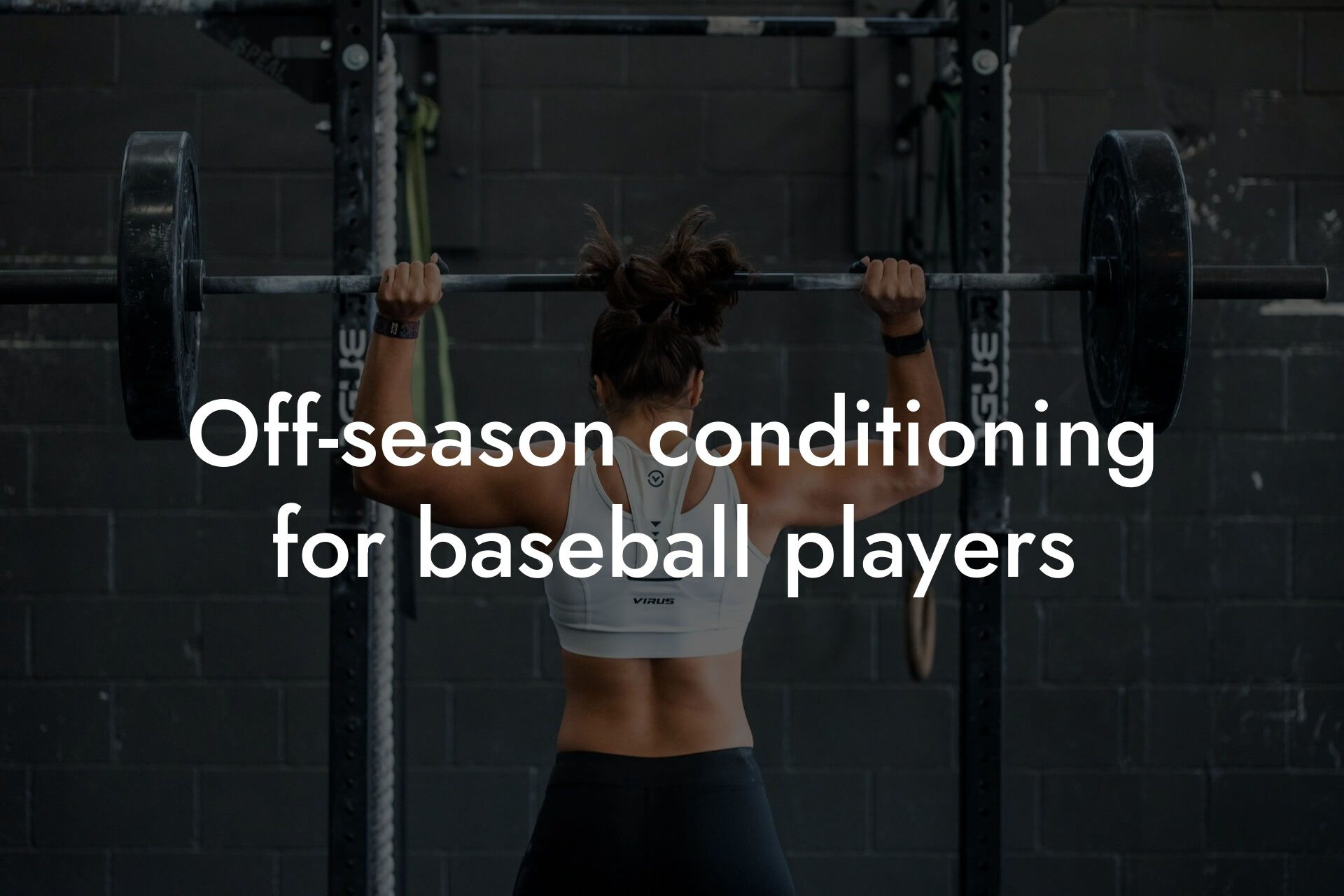Introduction
As a high-earning professional and baseball enthusiast, you understand the importance of maintaining a strong physique to excel in your sport. Baseball requires a unique combination of strength, power, speed, and agility, making it essential to strike a balance between muscle mass and flexibility. In this article, we'll delve into the importance of balancing muscle mass and flexibility in baseball, and provide you with expert tips and strategies to optimize your performance.
Table of Contents
The Importance of Muscle Mass in Baseball
Muscle mass is crucial for generating power, speed, and endurance in baseball. Having adequate muscle mass in the right areas, such as the legs, core, and upper body, enables you to hit the ball with force, run quickly around the bases, and maintain stamina throughout the game. A strong muscular foundation also helps prevent injuries, particularly in the shoulders, elbows, and knees, which are common areas of strain in baseball.
The Role of Flexibility in Baseball
Flexibility is often overlooked in baseball training, but it's equally essential for optimal performance. Good flexibility enables you to move efficiently, generate more power, and reduce the risk of injury. In baseball, flexibility is critical for activities such as:
- Swinging a bat: Flexibility in the shoulders, chest, and back allows for a more efficient swing, generating more power and speed.
- Throwing a ball: Flexibility in the shoulder and elbow enables you to throw with more velocity and accuracy.
- Running and fielding: Flexibility in the hips, legs, and lower back helps you move quickly and change direction rapidly.
The Consequences of Imbalance
If you focus too much on building muscle mass without incorporating flexibility exercises, you may experience:
- Reduced range of motion: Tight muscles can limit your ability to move freely, making it harder to swing, throw, or run.
- Increased risk of injury: Tight muscles and joints are more prone to strains, pulls, and tears.
- Decreased performance: Imbalanced muscle mass and flexibility can lead to poor technique, reduced power, and decreased speed.
Assessing Your Current Balance
To determine your current balance of muscle mass and flexibility, consider the following:
- DEXA scan: A DEXA scan can provide a detailed analysis of your body composition, including muscle mass and bone density.
- Range of motion tests: Perform simple exercises like shoulder rotations, hip flexor stretches, and hamstring curls to assess your flexibility.
- Performance metrics: Track your performance in games and training sessions to identify areas where you may be struggling.
Strategies for Balancing Muscle Mass and Flexibility
To achieve optimal balance, incorporate the following strategies into your training regimen:
- Periodized training: Alternate between strength training and flexibility exercises to avoid plateaus and prevent overtraining.
- Functional exercises: Incorporate exercises that mimic baseball movements, such as rotational strength exercises and plyometric training.
- Stretching and foam rolling: Regularly stretch and foam roll to improve flexibility and reduce muscle tension.
- Active recovery: Incorporate low-intensity exercises, such as yoga or cycling, to aid in recovery and maintain flexibility.
Nutrition and Supplementation
A well-balanced diet and strategic supplementation can also support your muscle mass and flexibility goals:
- Protein intake: Ensure you're consuming adequate protein to support muscle growth and repair.
- Omega-3 fatty acids: Omega-3s can help reduce inflammation and promote flexibility.
- Collagen supplements: Collagen can help improve joint health and flexibility.
Balancing muscle mass and flexibility is crucial for optimal performance in baseball. By understanding the importance of both, assessing your current balance, and incorporating strategies to improve your flexibility and muscle mass, you'll be well on your way to becoming a high-performing athlete. Remember to stay committed to your training, listen to your body, and make adjustments as needed. With the right approach, you can achieve peak performance and dominate on the field.
At Tano Performance Group, we're dedicated to helping high-earning professionals like you achieve their physical goals. Our state-of-the-art DEXA machine provides a comprehensive body assessment, giving you the insights you need to optimize your training and nutrition. Take the first step towards unlocking your full potential – contact us today to schedule your DEXA scan and start achieving your goals.
Frequently Asked Questions
What is the importance of balancing muscle mass and flexibility in baseball?
Balancing muscle mass and flexibility is crucial in baseball as it enables players to generate power, speed, and agility while reducing the risk of injuries. Having adequate muscle mass provides the strength needed for explosive movements, while flexibility allows for efficient movement patterns and reduces the risk of strains and pulls.
How does muscle mass impact baseball performance?
Muscle mass plays a significant role in baseball performance as it provides the strength and power needed for activities such as hitting, throwing, and running. Adequate muscle mass also helps to improve bat speed, ball velocity, and overall athleticism.
What are the consequences of having too much muscle mass in baseball?
Having too much muscle mass can lead to reduced flexibility, decreased range of motion, and increased risk of injury. Excessive muscle mass can also result in slower movements, reduced agility, and decreased overall performance.
How does flexibility impact baseball performance?
Flexibility is essential in baseball as it allows players to move efficiently and effectively. Good flexibility enables players to generate power, speed, and agility, while also reducing the risk of injuries. Flexible players can also maintain proper mechanics and technique, leading to improved performance.
What are the consequences of having poor flexibility in baseball?
Poor flexibility can lead to reduced power, speed, and agility, as well as increased risk of injury. Inflexible players may also experience decreased range of motion, poor mechanics, and reduced overall performance.
How can baseball players improve their muscle mass?
Baseball players can improve their muscle mass through a combination of proper nutrition, strength training, and rest. A diet rich in protein, complex carbohydrates, and healthy fats provides the necessary building blocks for muscle growth. A well-structured strength training program that targets all major muscle groups can also help to improve muscle mass.
What types of exercises are best for improving muscle mass in baseball?
Exercises that work multiple muscle groups at once, such as squats, deadlifts, and bench press, are effective for improving muscle mass in baseball. These exercises help to build strength and power in the legs, core, and upper body, which are essential for baseball performance.
How can baseball players improve their flexibility?
Baseball players can improve their flexibility through a combination of stretching exercises, foam rolling, and self-myofascial release. Regular stretching exercises can help to increase range of motion, reduce muscle tension, and improve overall flexibility.
What are the best stretches for baseball players?
The best stretches for baseball players include exercises that target the hamstrings, quadriceps, hip flexors, and shoulder muscles. Examples of effective stretches include leg swings, lunges, and shoulder rotations.
How often should baseball players stretch?
Baseball players should stretch regularly, ideally 2-3 times per week, to maintain and improve flexibility. Stretching exercises can be incorporated into warm-up and cool-down routines, as well as during rest days.
What is the ideal balance between muscle mass and flexibility in baseball?
The ideal balance between muscle mass and flexibility in baseball varies depending on the individual player's needs and position. However, a general rule of thumb is to aim for a balance of 60-70% muscle mass and 30-40% flexibility.
How can baseball players maintain their muscle mass and flexibility during the off-season?
Baseball players can maintain their muscle mass and flexibility during the off-season by continuing to engage in strength training and stretching exercises. A reduced intensity and volume of training can help to maintain muscle mass and flexibility, while also allowing for active recovery.
What are the benefits of incorporating plyometric exercises into a baseball training program?
Incorporating plyometric exercises into a baseball training program can help to improve power, speed, and agility, while also enhancing muscle mass and flexibility. Plyometric exercises, such as jump squats and box jumps, can help to improve explosive movements and overall athleticism.
How can baseball players incorporate agility training into their program?
Baseball players can incorporate agility training into their program through exercises that target quick changes of direction, reaction time, and speed. Examples of effective agility exercises include cone drills, ladder drills, and shuttle runs.
What is the importance of core strength in baseball?
Core strength is essential in baseball as it provides the stability and power needed for rotational movements, such as hitting and throwing. A strong core also helps to improve balance, agility, and overall athleticism.
How can baseball players improve their core strength?
Baseball players can improve their core strength through exercises that target the abdominal muscles, obliques, and lower back. Examples of effective core exercises include planks, Russian twists, and deadlifts.
What are the benefits of incorporating medicine ball exercises into a baseball training program?
Incorporating medicine ball exercises into a baseball training program can help to improve core strength, power, and rotational movement patterns. Medicine ball exercises, such as rotational throws and slams, can also help to enhance muscle mass and flexibility.
How can baseball players incorporate functional training into their program?
Baseball players can incorporate functional training into their program through exercises that mimic game-like movements and scenarios. Examples of functional exercises include agility ladder drills, cone drills, and reaction training.
What is the importance of proper nutrition in maintaining muscle mass and flexibility in baseball?
Proper nutrition is essential in maintaining muscle mass and flexibility in baseball as it provides the necessary building blocks for muscle growth and repair. A diet rich in protein, complex carbohydrates, and healthy fats can help to support muscle mass and flexibility.
How can baseball players ensure they are getting enough protein in their diet?
Baseball players can ensure they are getting enough protein in their diet by consuming protein-rich foods such as lean meats, fish, eggs, and dairy products. Aim to consume 1-1.5 grams of protein per kilogram of body weight daily.
What are the benefits of incorporating recovery techniques into a baseball training program?
Incorporating recovery techniques, such as foam rolling, self-myofascial release, and stretching, into a baseball training program can help to reduce muscle soreness, improve flexibility, and enhance overall recovery.
How can baseball players incorporate recovery techniques into their program?
Baseball players can incorporate recovery techniques into their program by dedicating 10-15 minutes per day to recovery exercises. This can be done during warm-up and cool-down routines, as well as during rest days.
What is the importance of proper sleep and rest in maintaining muscle mass and flexibility in baseball?
Proper sleep and rest are essential in maintaining muscle mass and flexibility in baseball as they provide the necessary time for muscle recovery and repair. Aim to get 7-9 hours of sleep per night and take rest days as needed.
Here are some related articles you might love...
- How DEXA scans can help baseball players optimize performance
- Recovery strategies for baseball athletes
- Off-season conditioning for baseball players
- Strength training programs for baseball athletes
- Reducing body fat for better speed on the bases
- The importance of core strength in baseball performance
- The role of body composition in baseball power and endurance
- Nutrition strategies for maintaining muscle during the baseball season
- Bone density and its impact on injury prevention in baseball
Zak Faulkner
Zak Faulkner is a leading authority in the realm of physical health and body composition analysis, with over 15 years of experience helping professionals optimise their fitness and well-being. As one the experts behind Tano Performance Group, Zak has dedicated his career to providing in-depth, science-backed insights that empower clients to elevate their physical performance and overall health.
With extensive knowledge of DEXA technology, Zak specializes in delivering comprehensive body assessments that offer precise data on body fat, muscle mass, bone density, and overall physique. His expertise enables individuals to make informed decisions and achieve their fitness goals with accuracy and confidence. Zak’s approach is rooted in a deep understanding of human physiology, combined with a passion for helping clients unlock their full potential through personalised strategies.
Over the years, Zak has earned a reputation for his commitment to excellence, precision, and client-focused service. His guidance is trusted by top professionals who demand the best when it comes to their health. Whether advising on fitness programs, nutritional strategies, or long-term wellness plans, Zak Faulkner’s insights are a valuable resource for anyone serious about taking their health and fitness to the next level.
At Tano Performance Group, Zak continues to lead our Content Team revolutionising how professionals approach their physical health, offering unparalleled expertise that drives real results.




